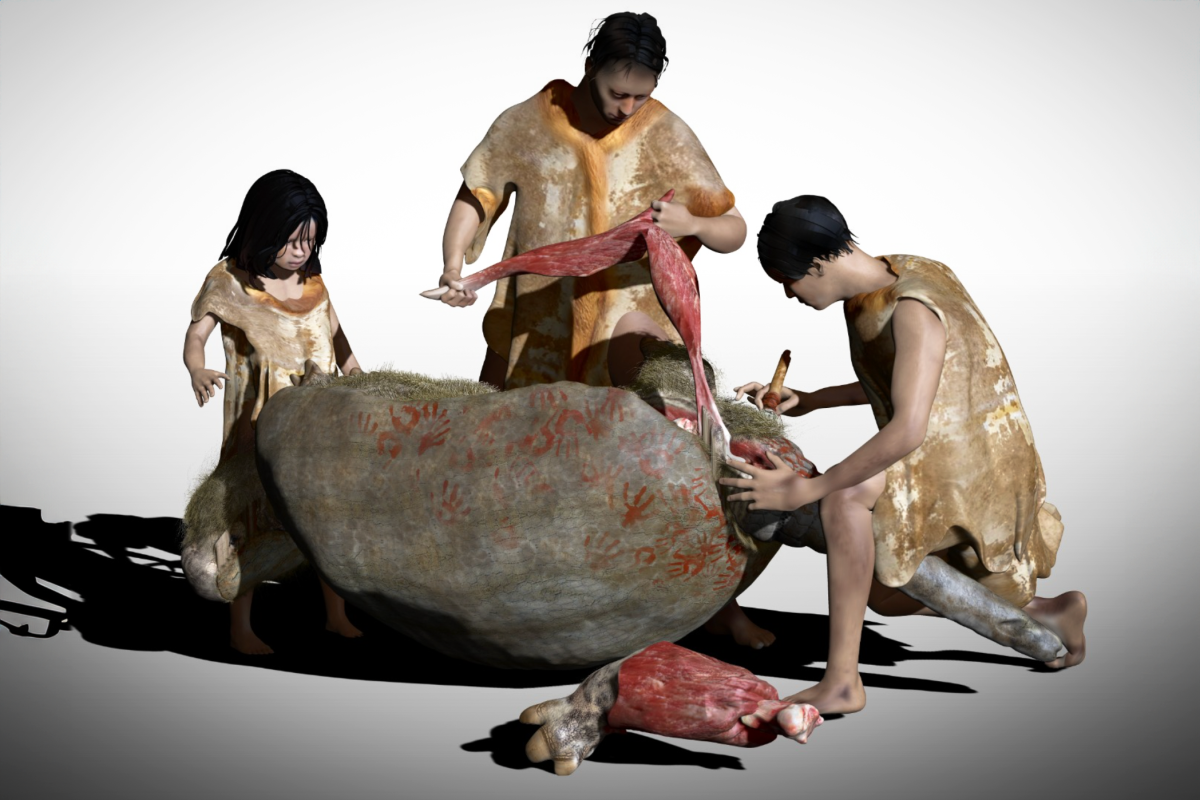
Humanity arrived in the Americas around 20,000 years ago because they already used kayaks and their like and the sea level was at least 300 feet lower. This meant that the entire Aleutians provided an ice dam and also a land bridge as well as local waters for movement.
So of course they came. They also could have come even sooner using any form of floatation system. Archeology tells us though that robust sea going natives existed over 20,000 years ago.
So here they are harvesting the big game. and we know that they did that anyway.
Ancient giant armadillo bones reveal oldest human existence in America
July 17, 2024
A 3D rendering of how hunter-gatherers would have processed the meat from these large armored mammals
https://newatlas.com/biology/megafauna-humans-south-america/?
When scientists recently dug up fossilized bones of a species of megafauna by a riverbank in Argentina, they found something even more fascinating than the remnants of this glyptodont. On those bones they found the type of cut marks not inflicted by other animals but by stone tools, in the process of primitive butchering. This would put human presence in the area at 21,000 years ago – some 5,000 years before people were thought to have settled in the Americas, according to most estimates.
Megafauna hunted by humans
The discovery by the Reconquista River, in Merlo, Buenos Aires, made by a team of scientists from the Natural Sciences Museum of the National University of La Plata (UNLP) in 2016, also provides a new understanding of how humans interacted with these huge animals, whose populations dwindled until they finally went extinct around 10,000 years ago.
“The marks found show a very particular distribution pattern, characteristic of cuts made by human action, which are also observed in different parts of the tail of this specimen, which allowed us to establish that it was humans who used it as part of their diet," said Mariano Del Papa, a Doctor in Natural Sciences at UNLP.
The bones showed the tell-tale scars of stone-tool impacts, telling researchers they were inflicted by humans, not by the teeth of another animal
UNLP
When the well-preserved bones – a large plate from the pelvic girdle, caudal vertebrae and caudal tube – were arranged in the way they would have been found in a complete skeleton, the scientists found that the cut marks in the fossils were not consistent with the teeth of other animals, but followed the cutting patterns made by hunter-gatherers when removing meat from a carcass.
"Once the specimen was recovered from the site, the sediments containing the specimen were cleaned," said Del Papa. "This stage was documented in detail, recording the position of the anatomical units and the distribution of the sediments. These first results allowed us to realize that once the butchering tasks were carried out by the hunters, the remains underwent a rapid natural burial process, allowing an exceptional state of conservation for the study of the cut marks.”
Sediment testing from the dig site dated the bones to be around 21,000 years old
UNLP
Del Papa, with fellow researchers Martín de Los Reyes and Miguel Delgado Burbano, conducted radiocarbon dating of the bones and the riverside sediment they were encased in. They also performed a chemical analysis of that same soil, as well as 3D scans and quantitative analysis of the cuts.
"To determine the age of the animal, they relied on studies commonly used to define the age of stratigraphic and radiometric rocks," said de Los Reyes. "The glyptodont was found in the oldest layer or stratum, that is, at the base of the riverside ravines. Comparing it with previous geological studies in the area, the discovery was placed within the last glacial maximum of the Pleistocene, some 20,000 years before the present."
A reconstruction of a glyptodont, from what we have discovered so far
What they found was that this Neosclerocalyptus species – a two-tonne, heavily armored grass-eating armadillo – was hunted and butchered by humans some 5,000 years earlier than science believed that people had arrived in this part of the world.
"The paradigm of the settlement of the continent suggests that humans entered America about 16,000 years ago, but it turns out that in recent years much older evidence has begun to appear in Brazil, Canada, the United States and Mexico, among other places," said Delgado, a professor at the Faculty of Natural Sciences at UNLP. "There is a traditional view that says that these findings are anomalies, that it is not known exactly how they occurred, but there is a growing number of very serious studies published in the most prestigious scientific journals, which place the first entry between 20 and 30 thousand years ago."
No comments:
Post a Comment